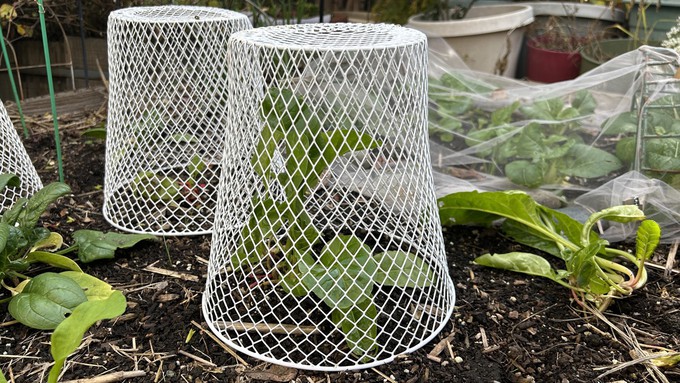
Easily found and budget-friendly items for gardeners

These wire wastebaskets can protect young plants, while tulle fabric, in background, can be used as floating row cover for brassicas in a small garden. Kathy Morrison
Still shopping? Or still being asked for gift ideas for yourself? Here are my five favorite gardening hacks that use inexpensive items not generally thought of for gardening:
– Wire wastebaskets, found at just about any dollar store. A fellow gardener, of course, tipped me off to the usefulness of these baskets in protecting small transplants from squirrels, birds or roving pets. They come in a couple of sizes, but I like the taller ones. (Use garden staples to hold them down if necessary.) I have them over my smaller chard and spinach plants right now, see the photo above.
– Several yards of tulle, available at fabric stores. This pen-weave polyester fabric is often used in ballet costumes and wedding veils, but I’ve found it incredibly useful in the garden. (I bought 10 yards this past spring.) It’s much cheaper than bird netting, and much safer for the birds. I use it on berry bushes and as a small floating row cover over the bok choy in my raised bed. (In background of photo.) You can sew it together to make a large cover if needed. It’s reusable and washable. And it comes in many colors, which adds some whimsy to the vegetable garden.
– Wooden spring clothespins, available at most hardware stores. These come 36 to a package, and they’re invaluable for anchoring shade cloth on tomato cages. But I also use them to clip tags on pots, affix tulle around berry plants and temporarily close seed or fertilizer packages. The wooden ones last much longer than the plastic ones.
– Painters tape, sold at hardware and other stores. I go through a roll of this every year, using a Sharpie on the tape to mark sixpacks of tomato starts, then the seedlings when they’re repotted. The taped tags don’t flip out of the sixpacks or pots like classic plant tags can, and can’t get accidentally mixed up. The tape also can close seed packages without destroying the paper or the info on them. Tip: Get a good brand, whether 1-1/2 inches or wider, green or blue, because the cheap stuff will quickly drive you crazy.
– Cup hooks, especially the kind with the closing clip, at hardware and home goods stores. Screw one into a wooden post or fence to help anchor a leaning plant with stretch tape, or use more hooks to hold a string trellis for flowers or shade cloth for new plantings.
Looking for more gift ideas? Here's a post with suggestions I wrote last year.
Comments
0 comments have been posted.Sacramento Digs Gardening to your inbox.
Sites We Like
Garden Checklist for week of July 21
Your garden needs you!
* Keep your vegetable garden watered, mulched and weeded. Water before 8 a.m. to reduce the chance of fungal infection and to conserve moisture.
* Feed vegetable plants bone meal, rock phosphate or other fertilizers high in phosphate to stimulate more blooms and fruiting. (But wait until daily high temperatures drop out of the 100s.)
* Don’t let tomatoes wilt or dry out completely. Give tomatoes a deep watering two to three times a week.
* Harvest vegetables promptly to encourage plants to produce more. Squash especially tends to grow rapidly in hot weather. Keep an eye on zucchini.
* Pinch back chrysanthemums for bushy plants and more flowers in September.
* Remove spent flowers from roses, daylilies and other bloomers as they finish flowering.
* Pinch off blooms from basil so the plant will grow more leaves.
* Cut back lavender after flowering to promote a second bloom.
* It's not too late to add a splash of color. Plant petunias, snapdragons, zinnias and marigolds.
* From seed, plant corn, pumpkins, radishes, winter squash and sunflowers.